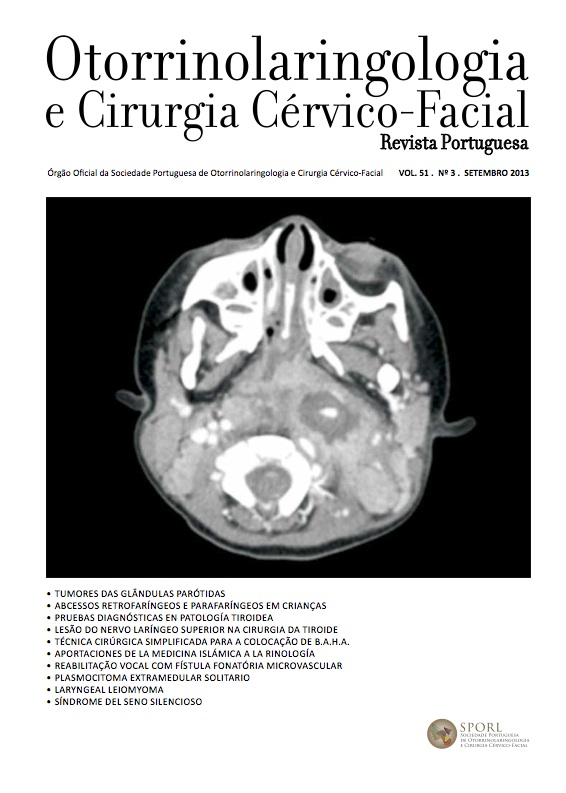Mecânica de Fluídos Computacional aplicada ao estudo do impacto de perfurações septais na fisiologia nasal
DOI:
https://doi.org/10.34631/sporl.1029Palavras-chave:
Mecânica de Fluídos Computacional (CFD), Septo nasal, Perfuração septal, Cirurgia virtualResumo
Objectivos: Utilização de mecânica de fluídos computacional (MFC) na compreensão do impacto do tamanho e localização das perfurações septais (SP) na fisiologia nasal.
Desenho de estudo: Estudo de simulação computacional.
Material e Métodos: O Software de MFC (Flowgy®) foi utilizado na criação de modelos digitais de fossas nasais através da reconstrução de tomografias computadorizadas (TC). Foi realizada cirurgia virtual com estabelecimento de PS anteriores (1 ou 2cm) e posteriores (1 ou 2cm).
Resultados: Perfurações de maiores dimensões causaram maior alteração na alocação do fluxo de ar independente da localização, com desvio de ar da fossa nasal com maior fluxo para a de menor fluxo. A resistência nasal bilateral não foi significativamente alterada pela presença de PS.
Conclusões: As tecnologias de MFC auxiliam na compreensão de como as PS alteram a fisiologia nasal. A alocação do fluxo de ar é alterada, com maior fluxo de ar pela fossa nasal de menor resistência, principalmente nas perfurações anteriores.
Downloads
Referências
Lustig LR, Arts HA, Brackmann DE, Francis HF, Molony T, Megerian CA. et al. Hearing Rehabilitation using the BAHA bone-anchored hearing aid: results in 40 patients. Otol Neurotol. 2001 May;22(3):328-34. doi: 10.1097/00129492- 200105000-00010.
Roman S, Nicollas R, Triglia JM. Practice guidelines for bone-anchored hearing aids in children. Eur Ann Otorhinolaryngol Head Neck Dis. 2011 Nov;128(5):253-8. doi: 10.1016/j.anorl.2011.04.005.
Häkansson B, Tjellstrom A, Rosenhall U. Hearing thresholds with direct bone conduction versus conventional bone conduction. Scand Audiol. 1984;13(1):3- 13. doi: 10.3109/01050398409076252.
Verstraeten N, Zarowski AJ, Somers T, Riff D, Offeciers EF. Comparison of the audiologic results obtained with the bone anchored hearing aid attached to the headband, the test band, and to the ‘snap’ abutment. Otol Neurotol. 2009 Jan;30(1):70-5. doi: 10.1097/MAO.0b013e31818be97a.
Holgers KM, Thomsen P, Tjellström A, Bjursten LM. Immunohistochemical study of the soft tissue around long-term skin-penetrating titanium implants. Biomaterials. 1995 May;16(8):611-6. doi: 10.1016/0142- 9612(95)93858-b.
Holgers KM, Tjellström A, Bjursten LM, Erlandsson BE. Soft tissue reactions around percutaneous implants: a clinical study of soft tissue conditions around skin- penetrating titanium implants for bone-anchored hearing aids. Am J Otol. 1988 Jan;9(1):56-9.
Kruyt IJ, Nelissen RC, Johansson ML, Mylanus EAM, Hol MKS. The IPS-scale: a new soft tissue assessment scale for percutaneous and transcutaneous implants for bone conduction devices. Clin Otolaryngol. 2017 Dec;42(6):1410- 1413. doi: 10.1111/coa.12922.
Costa JR, Costa S, Soares T, Feliciano T, Sousa CA, Coutinho MB. Skin and soft tissue complications of bone- anchored hearing aids: Introducing a new classification system. Acta Otorrinolaringol Esp. [Internet] 2022 Mar. Available from: https://doi.org/10.1016/j.otorri.2022.01.001
de Wolf MJ, Hol MK, Huygen PL, Mylanus EA, Cremers CW. Clinical outcome of the simplified surgical technique for BAHA implantation. Otol Neurotol. 2008 Dec;29(8):1100- 8. doi: 10.1097/MAO.0b013e31818599b8.
Gordon SA, Coelho DH. Minimally invasive surgery for osseointegrated auditory implants: A comparison of linear versus punch techniques. Otolaryngol Head Neck Surg. 2015 Jun;152(6):1089-93. doi: 10.1177/0194599815571532
Fontaine N, Hemar P, Schultz P, Charpiot A, Debry C. BAHA implant: implantation technique and complications. Eur Ann Otorhinolaryngol Head Neck Dis. 2014 Feb;131(1):69-74. doi: 10.1016/j.anorl.2012.10.006.
Kruyt IJ, Nelissen RC, Johansson ML, Mylanus EAM, Hol MKS. The IPS-scale: a new soft tissue assessment scale for percutaneous and transcutaneous implants for bone conduction devices. Clin Otolaryngol. 2017 Dec;42(6):1410- 1413. doi: 10.1111/coa.12922.
Monksfield P, Chapple IL, Matthews JB, Grant MM, Addison O, Reid AP. et al. Biofilm formation on bone- anchored hearing aids. J Laryngol Otol. 2011 Nov;125(11):1125- 30. doi: 10.1017/S0022215111002143.
Calon TGA, Trobos M, Johansson ML, van Tongeren J, van der Lugt-Degen M, Janssen AML. et al. Microbiome on the bone-anchored hearing system: a prospective study. Front Microbiol. 2019 Apr 26;10:799. doi: 10.3389/ f micb.2019.00799
Samoy K, Goeteyn M, Lerut B. Laser epilation as a treatment for recurrent infections around bone conduction implant abutment. Ann Otolaryngol Rhinol. [Internet] 2016; 3(7): 1116. Available from: https://www.jscimedcentral. com/Otolaryngology/otolaryngology-3-1116.pdf.
Falcone MT, Kaylie DM, Labadie RF, Haynes DS. Bone-anchored hearing aid abutment skin overgrowth reduction with clobetasol. Otolaryngol Head Neck Surg. 2008 Dec;139(6):829-32. doi: 10.1016/j.otohns.2008.08.021.
Hildrew DM, Guittard JA, Carter JM, Molony TB. Clobetasol's influence on the management and cost of skin overgrowth associated with the bone anchored hearing aid. Ochsner J. Fall 2015;15(3):277-83.
Van Rijswijk JB, Mylanus EA. Intralesional triamcinolone acetonide injection in hypertrophic skin surrounding the percutaneous titanium implant of a bone-anchored hearing aid. J Laryngol Otol. 2008 Dec;122(12):1368-70. doi: 10.1017/S0022215107001673.
Downloads
Publicado
Como Citar
Edição
Secção
Licença
Direitos de Autor (c) 2024 Os autores mantêm os direitos de autor deste artigo.

Este trabalho encontra-se publicado com a Licença Internacional Creative Commons Atribuição-CompartilhaIgual 4.0.






